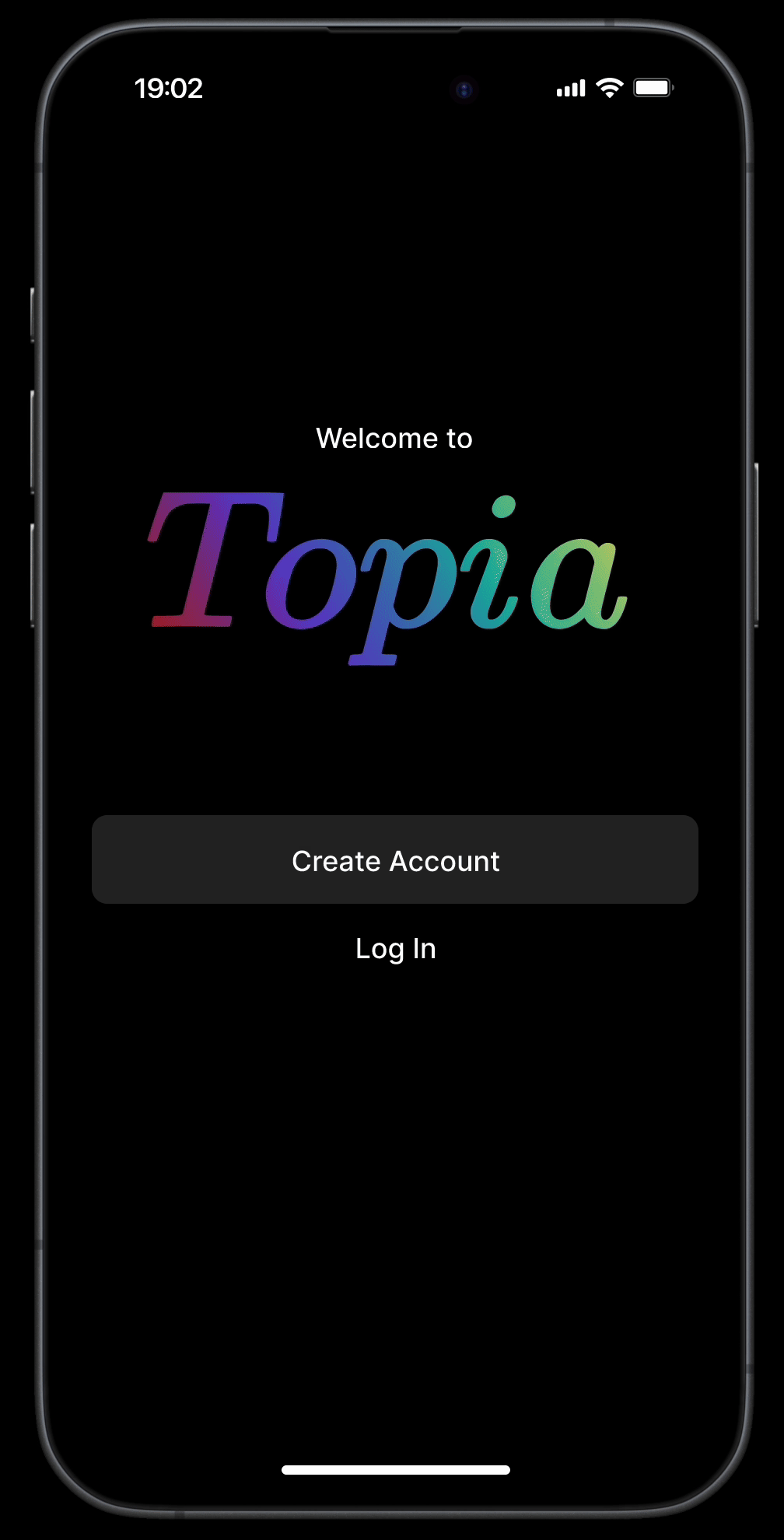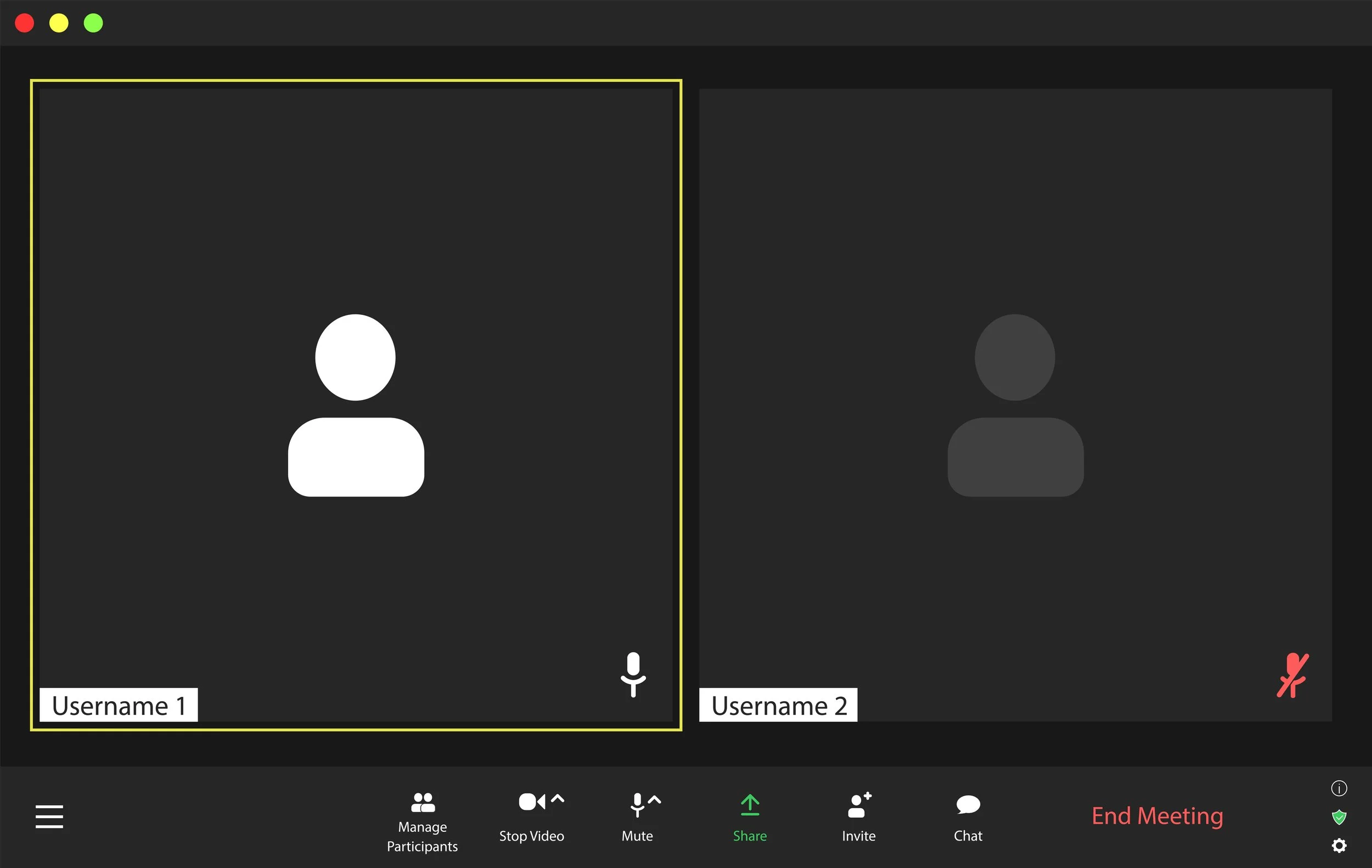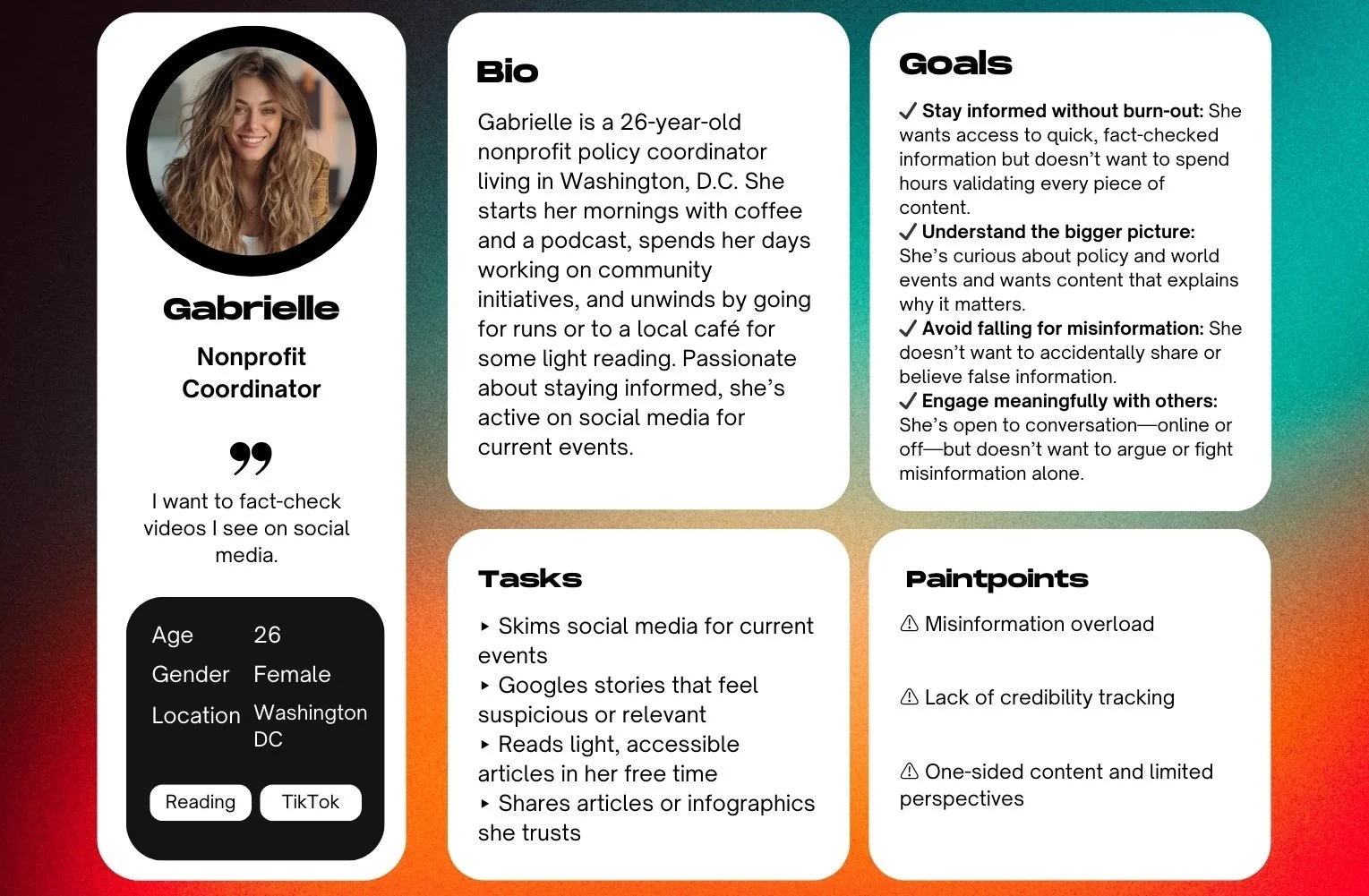TOPIA
Welcome to the
Future of Digital Trust
Topia is a platform designed to help users engage more critically with everyday content they see online. Born out of a desire to combat misinformation without disrupting familiar scrolling behaviors, this solution integrates AI-powered credibility tools directly into the content flow. Through a human-centered approach, Topia reimagines the future of digital trust.
-
Initial research and topic exploration
-
Problem framing and competitive analysis
-
User interviews and reflections
-
Persona development
-
Presentation building
-
Midpoint recap and presentation (Capstone Part 1 close)
The design process spanned 16 weeks and followed a human-centered, research-driven approach.
project TIMELINE
-
Journey mapping and storyboarding
-
User flows and early wireframes
-
High-fidelity prototyping (Prototype I) and usability testing
-
Synthesis, revisions, and visual updates
-
Iterative testing and polish
-
Final presentation and case study creation
Process Overview
Problem Framing & Discovery
This project began by analyzing misinformation trends and identifying a core user problem through early desk research and behavioral insights.
User
Interviews
The research phase included six in-depth interviews to explore how users engage with information on social platforms and react to potentially misleading content.
Personas & Journey Mapping
Insights from the interviews informed two user personas, along with current- and future-state journey maps that highlighted key pain points and opportunity areas.
User Flows & Storyboard
The in-app experience was designed to guide users from onboarding to exploration through familiar gestures like swiping, tapping, and scrolling. To ease adoption, the interface prioritized a vertical scroll format users already knew, so new credibility features would feel intuitive rather than overwhelming.
Prototyping & Usability Testing
The product evolved from low-fidelity wireframes into a high-fidelity prototype shaped by user behaviors, pain points, and iterative testing. Each screen was refined to reflect key usability principles: to minimize cognitive load, supporting learnability, and maintaining consistency across interactions.
Final Iteration
Final adjustments were guided by user feedback and focused on clarity, trust, and ease of use. Updates to onboarding, tutorial gestures, and the sources page made the experience more intuitive and better aligned with users’ expectations.
the problem
social media fueling misinformation
2008-2012: Expansion of social media
Facebook, Twitter, and YouTube explode in popularity.
No regulation on content accuracy results in misinformation spreading freely.
Viral content becomes more valuable than verified content.
2016: Election Year
Fake news articles receive 8.7M shares outcompeting real news.
Foreign interference (e.g., Russian bots) influences U.S. voters.
Social media companies start facing public scrutiny from Congress and advocacy groups, but little action is taken to resolve the spread of misinformation.
2020: The pandemic
False COVID-19 cures, conspiracy theories, and misinformation flood social feeds.
WHO calls it an "Infodemic" where misinformation spreads faster than
the virus.
Social media platforms introduce fact-checking labels, but engagement-driven algorithms still push misleading content.
Present day
Algorithms continue prioritizing engagement over truth.
AI-generated misinformation (deepfakes, manipulated images and videos) becomes harder to detect.
No widely adopted solution exists to combat false information.
Problem Statement
A social media user who feels overwhelmed needs to fact check information — but faces confusion and fatigue.
Conducting Interviews
To identify an ideal group for testing, a screener survey was released to find individuals who either:
[a] actively use social media to stay informed or
[b] intentionally avoid social media as a source to learn new information
Representative Sampling Methods: A group of six individuals was selected to reflect the key characteristics of the target user population most likely to benefit from this solution. One intentional outlier—someone less likely to use the platform—was also included to help uncover edge-case pain points and broaden the design perspective.
Target Audience
From the interviews, we narrowed down our target audience which will be used to develop User Type 1: Content Creator, personas.
Audience
Curious, Scroll-first Users who want fast, digestible facts without leaving the app
Professionals balancing social media with civic awareness and daily responsibilities
College Students navigating misinformation while saturated in demanding academic and social lifestyles
Informed Skeptics seeking clarity by cross-checking claims before forming opinions
Users don’t fully trust content at first glance but rarely take time to verify it.
Credibility is often judged by surface cues like popularity or “.org” / “.gov” domains.
Participants expressed frustration and wanted to understand why something is true or false.
Users prefer layered information — some want quick clarity, others want deeper context.
Fact-checking is seen as an extra step, and most users admitted to skipping it entirely.
Key Findings
the SOLUTION
Designing Credibility Into the Scroll
Rather than disrupting how people consume content, Topia integrates fact-checking tools into familiar interactions and gestures, helping users assess accuracy without ever leaving the feed.
Key Features
AI Credibility Scores: Before appearing in the feed, each video is scanned and assigned a credibility score based on accuracy, tone, and source reliability.
Tap-to-Expand Analysis: Users can tap to open a full overview explaining why content was rated a certain way.
Source Integration: Linked articles are color-coded and categorized by origin: either added by the content creator or sourced by AI.
Ask AI Anything: A built-in AI messaging tool empowers users to dive deeper and ask follow-up questions.
From Idea to
Interaction
The Prototype
This is Prototype I, designed to solve for User Type 1 pain points. The focus of Prototype I includes:
Simple Onboarding
Gesture-Based Navigation Tutorial
Transparent Credibility Scoring
Integrated In-App Sources
“Discover More” by Asking AI
Smart Save Features with Categories (Explore More, Add a Note)
These features are designed to complement users’ natural scroll behavior, adding value without disruption.
Each step of this 16-week process, from early research and interviews to wireframing and testing, clarified what users need most when learning online: a tool that helps them think critically and form their own opinions with confidence.
Reflections
✦
Challenges
✦
Next Steps
✦
Reflections ✦ Challenges ✦ Next Steps ✦
Reflections
Clarity vs. Complexity
I learned that successful UX design is not about removing complexity entirely, but organizing it in a way that feels approachable, layered, and easy to navigate.
Don’t
Oversimplify
Users were not satisfied with a label that oversimplified information— they wanted context that explained why content was flagged and how that decision was made.
Create a Safe Space
Designing for heavy topics like misinformation meant creating a user interface and community space where users could explore without feeling judged or overwhelmed.
UX Is About Precision
Every swipe, tap, and animation needed to carry meaning. Making small adjustments to clarify gestures had a huge impact on usability and trust.
People want authentic interactions
Participant interviews revealed how deeply people value honesty and transparency in today’s social media landscape. For Topia to succeed, users need to feel like they’re in control—not that AI is making critical decisions on their behalf.
Beyond the Classroom
Topia challenged me to create something that could live in the real world, and sparked ideas for how this concept might evolve post-graduation.
Challenges
Challenge 1
Some participants expressed concern about relying on AI to distinguish fact from fiction — especially as deepfakes and manipulated media become more common. Transparency emerged as a key solution, not just in how the AI operates, but also in giving users the ability to flag inaccuracies themselves. To address this, I plan to develop a content creator prototype that reveals how the AI assesses accuracy. This version will include required fields for creators, such as transcript uploads and linked sources, giving the AI more context to evaluate content clearly and fairly.
Challenge 2
A recurring pain point in participant interviews was the fear of echo chambers. Users were skeptical of platforms that reinforce their existing beliefs and limit exposure to differing perspectives. This finding highlighted the importance of rethinking the algorithm. In response, I began designing a system that balances each user’s feed by blending three types of content: aligned, neutral, and opposing viewpoints.
Challenge 3
Due to time constraints, the AI overview wasn’t fully developed to match the project’s vision. The goal was to make this section feel intuitive — reflecting how humans naturally absorb information. However, the current layout creates cognitive overload and lacks accessibility. It relies too heavily on dense text and assumes users are comfortable interpreting complex information without guidance. Further refinement is needed to simplify the interface and support more diverse reading styles.
NExt Steps
The next phase will explore how AI models can assess credibility without relying solely on user feedback models — beginning with a conversation with the team at Claude, a language model known for its strong reasoning abilities and transparent outputs. Claude offers a promising foundation for evaluating nuance and tone, both of which are critical to credibility scoring.
Usability testing for User Type 1, the content viewer, will expand to include outlier groups such as individuals with low digital literacy or limited engagement with fact-based content.
Further research will focus on User Type 2, content creators, by identifying tools and incentives that encourage credible, transparent sharing.
about the Creator
Taylor Zlab is a multidisciplinary designer and UX researcher with a background in social media strategy, graphic design, and user experience design. She has led creative projects across public art, education, and nonprofit sectors, bringing a research-driven approach and strong sense of storytelling to every challenge. Taylor specializes in building digital experiences that prioritize clarity, accessibility, and meaningful engagement — especially in fast-moving, high-content environments. She developed Topia as a capstone project to explore how credibility tools could be integrated into everyday scrolling, helping users stay informed without breaking their flow.
Taylor is passionate about using design as a tool for curiosity, trust, and real-world impact.











